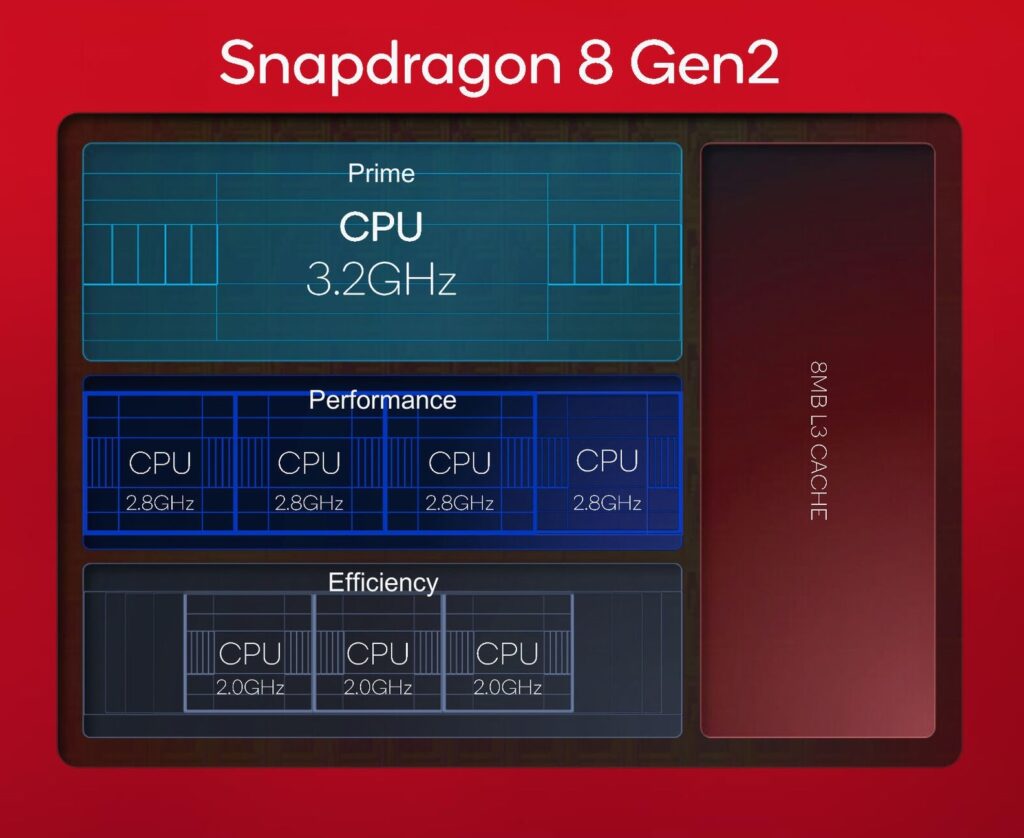
Apple has recently introduced the iPhone 15 Pro series along with its latest mobile processor, the A17 Pro. Unlike previous generations, Apple has dropped the “Bionic” branding to better align with the Pro series. The A17 Pro comes equipped with a redesigned GPU, a highly efficient CPU, a powerful Neural engine, and numerous other enhancements. But how does it stack up against the Qualcomm Snapdragon 8 Gen 2 processor? To answer this question, let’s delve into a detailed comparison between the Apple A17 Pro and Snapdragon 8 Gen 2, exploring their distinctions and commonalities.
Apple A17 Pro vs Snapdragon 8 Gen 2: Specifications Comparison
Let’s examine the specifications comparison between the Apple A17 Pro and Snapdragon 8 Gen 2 to gain a comprehensive overview of these two mobile processors.

Apple A17 Pro vs Snapdragon 8 Gen 2: CPU Comparison
In this comparison between the Apple A17 Pro and Qualcomm Snapdragon 8 Gen 2, let’s start by examining their CPUs. Apple has opted for its traditional six-core configuration. Notably, the A17 Pro stands out as the first mass-produced chip manufactured using TSMC’s advanced 3nm process, likely the first-generation N3B process. This technological leap has resulted in an impressive 19 billion transistors packed onto a single chip.

The CPU within the A17 Pro consists of two high-performance cores clocked at 3.70 GHz, representing a 10% performance improvement over the previous Everest cores. Furthermore, Apple has integrated four power-efficient CPU cores, which Apple claims to be the most efficient mobile CPU cores. These cores deliver 3 times the performance per watt compared to the competition, with the reference likely being the A510 core. Therefore, when considering both CPU performance and efficiency, Apple has made substantial advancements with the A17 Pro, largely owing to the cutting-edge TSMC 3nm process node.
Turning our attention to the year-old Snapdragon 8 Gen 2, it is constructed using TSMC’s 4nm process (N4 process) and boasts an octa-core CPU design. This design follows a 1+(2+2)+3 CPU cluster configuration, featuring a single potent Cortex-X3 core clocked at 3.2GHz, 2x Cortex-A715 cores running at 2.8GHz, 2x Cortex-A710 cores also clocked at 2.8GHz, and 3x Cortex-A510 cores with a clock speed of 2.0GHz.

Notably, the maximum clock speed of the primary core in the Snapdragon 8 Gen 2 is 3.2GHz, which falls significantly short of the A17 Pro’s impressive 3.70GHz frequency. This suggests that the A17 Pro is poised to establish a significant lead in single-threaded tasks. Even when considering the leaked CPU details for the upcoming Snapdragon 8 Gen 3 chip, it appears that Qualcomm may not be in a position to surpass Apple this year. The Snapdragon 8 Gen 3 is rumored to feature a (1+3+2+2) CPU design and include a prime Cortex-X4 core clocked at 3.39GHz, which still falls short of the A17 Pro’s 3.70GHz.
To provide you with a clearer perspective, here are the Geekbench 6 scores (leaked Snapdragon 8 Gen 3) for all three chips. It’s worth noting that the leaked scores for the Snapdragon 8 Gen 3 should be taken with some caution, as OEMs are still fine-tuning the chip to extract the best possible performance.

Apple A17 Pro vs Snapdragon 8 Gen 2: GPU Comparison
When it comes to the GPU, this year holds some exciting developments. We remember how Qualcomm’s Adreno 740 outperformed Apple’s 5-core GPU in both performance and efficiency last year. Consequently, Apple has made a concerted effort to reclaim the GPU throne from Qualcomm this year. Apple has introduced a new Pro-class GPU based on shader architecture, aiming for unmatched performance and efficiency. The A17 Pro’s new GPU boasts 6 cores, as opposed to the previous 5, resulting in a 20% boost in performance compared to its predecessor.

It’s worth noting that in the previous year, the GPU performance gap between the A15 Bionic and A16 Bionic was a mere 5%. Therefore, the 20% year-over-year improvement with the Apple A17 Pro feels significant. Additionally, Apple has introduced hardware-accelerated ray tracing support with the Pro-class GPU in the A17 Pro, adding an exciting dimension to its graphics capabilities.
Apple boasts that its ray tracing capabilities on the new GPU are four times faster than the software-based graphics rendering found on the A16 Bionic. Additionally, a novel feature named MetalFX Upscaling leverages both the GPU and Neural Engine to deliver high-quality graphics while consuming less power.

Furthermore, with the iPhone 15 Pro series, users will have the capability to play console-quality games such as Resident Evil Village, Resident Evil 4, Death Stranding, Assassin’s Creed Mirage, and others. For gaming enthusiasts, the A17 Pro’s new Pro-class GPU presents a compelling case. Although the older Adreno 740 GPU on the Snapdragon 8 Gen 2 has performed admirably and supports features like hardware-accelerated ray tracing, the new 6-core GPU on the A17 Pro appears to be the victor.
Of course, a comparison with the upcoming Adreno 750 GPU on the Snapdragon 8 Gen 3 is on the horizon, but for the time being, Apple has managed to reclaim the lead in this arena.
A17 Pro vs Snapdragon 8 Gen 2: ISP Comparison
Apple did not provide extensive details about the Image Signal Processor (ISP) of the A17 Pro during the event, but it has highlighted that its Photonic engine now powers most of the camera capabilities, including Night mode and portraits. Additionally, Apple has announced the upcoming introduction of Spatial video recording for the iPhone 15 Pro series early next year. This feature is set to provide a depth-enhanced experience through Apple Vision Pro, allowing users to relive memories in a more immersive way. Furthermore, the A17 Pro’s capable ISP enables users to capture 48MP ProRAW images and shoot 4K60 ProRes videos.

On the other hand, the Snapdragon 8 Gen 2 features an 18-bit triple ISP architecture with support for capturing 8K HDR videos and the ability to take photos with resolutions up to 200MP. On paper, it appears that the Snapdragon 8 Gen 2 has an advantage in terms of raw image processing capabilities. However, practical experience has shown that videos shot on iPhones often outperform those taken with flagship Android smartphones. Therefore, it’s essential to consider real-world performance rather than relying solely on specifications when assessing the capabilities of the ISPs in both of these processors.
A17 Pro vs Snapdragon 8 Gen 2: AI and ML Comparison
The A17 Pro has made significant strides in the field of artificial intelligence (AI) and machine learning (ML). With its new 16-core Neural Engine, the A17 Pro delivers a staggering 2x improvement in performance compared to the A16 Bionic. This enhancement translates to an astonishing 35 trillion operations per second (TOPS) of AI processing power. To put this into perspective, last year’s A16 Bionic managed only 17 TOPS, and within just one year, Apple has doubled the AI performance.

In contrast, Qualcomm has a strong track record in developing efficient AI engines. Even the older Snapdragon 8+ Gen 1 SoC already delivered 27 TOPS of AI performance, and the Snapdragon 8 Gen 2 further optimized the AI engine. Now, all eyes are on Qualcomm’s upcoming Snapdragon 8 Gen 3 to see if it can surpass Apple in the AI race. The competition in the AI domain between these two giants remains an intriguing aspect of the ongoing rivalry.
A17 Pro vs Snapdragon 8 Gen 2: 5G Modem & Wireless Comparison
Apple did not extensively discuss 5G connectivity during their presentation, but the Apple A17 Pro is equipped with a discrete 5G modem from Qualcomm, likely the Snapdragon X70 5G modem, which is also integrated into the Snapdragon 8 Gen 2. Notably, Apple recently extended its agreement with Qualcomm to provide 5G modems until 2026.
In terms of 5G connectivity, the A17 Pro features a highly capable modem capable of delivering speeds up to 10Gbps and supporting both mmWave and sub-6 GHz frequency bands. Additionally, the A17 Pro offers support for Wi-Fi 6E and Bluetooth 5.3.

On the other hand, the Snapdragon 8 Gen 2 is equipped with the X70 5G modem and incorporates the latest radio advancements. It also boasts Bluetooth 5.3, LE (Low Energy), and Wi-Fi 7 for local connectivity. It’s worth noting that this year, Apple has added support for NavIC with the A17 Pro, ensuring that both flagship chips now support India’s navigation satellite system. This inclusion enhances the device’s navigation capabilities in the Indian market.
Apple A17 Pro Outperforms Snapdragon 8 Gen 2
In many respects, comparing the Apple A17 Pro with the Snapdragon 8 Gen 2 seems unfair, given that the latter is nearly a year old. However, this comparison does provide insight into the substantial progress Apple has made in competing with others over the past year. It also sets a benchmark for the upcoming Snapdragon 8 Gen 3, indicating the areas where Qualcomm needs to focus on to narrow the gap once more.
From the comparison, it’s evident that Apple has once again established a significant lead in the CPU, GPU, and AI departments. Now, the tech world eagerly awaits Qualcomm’s response and whether they can surpass Apple’s performance. The ongoing competition between these two giants will continue to shape the future of mobile technology, and only time will reveal the ultimate victor in this ever-evolving race.



0 Comments